
|
SIGNS & HOUSES
The General and Particular Copyright © 2007 All Rights Reserved by Wim van DamINTRODUCTIONIn this article I want to discuss what is probably the most vexing problem in astrology, and that is: How to tackle a horoscope, especially a blind one, and to reach clear (not vague but specific) results with a high percentage of probability. The problem is known under several names ("at present our knowledge of astrology is comparable to knowing only words of a language and not knowing how to choose them or to compose sentences", to paraphrase James Holden's Word-problem, or "one can interpret the parts of a horoscope in so many different ways that one cannot choose", Rob Hand's poly-interpretability problem, as I prefer to call it). The problem is even more complicated than it seems at first sight. Not only don't we know how to interpret a planet's position in a house, we even don't know whether its influence will make itself clear by the house position or by the house it rules or by a house (if any) whose cusp is strongly aspected by it or all of the above. USE OF ASTROLOGY HANDBOOK FOR CHART ANALYSISMost astrologers in practice think they have a simple solution by consulting their favourite astrology handbook of that moment for each planet's position in sign and in house and trying to render the found text in an acceptable way and the same for each planetary aspect. This usually does not give any interesting result at all. The reason is that this method implicitly assumes that each horoscopic indication relates to one fixed interpretation that can be rendered in for example, half a page of text. Simple pondering shows this is impossible. Each position of a planet in a sign takes some days or even several years and one really can't assume that this means any one born during this period will experience the same facts and/or events in life. House positions do not help much either: Therefore, even if one writes a textbook with 144 descriptions for each individual planet (12 signs multiplied by 12 houses) this would not really help much. In fact, this number of 144 interpretations should be multiplied by 12 again, for each planet can rule at least one of the twelve houses and cast aspects to any cusp. Doing so however, we still would not have a reliable textbook. Usually, if the horoscope of a well-know person is analysed, the astrologer does not have any problem in explaining every fact that he/she knows about the native's life: for every desired fact he/she will easily find a fitting indication. But here the problem is, it will not be difficult to find other horoscopes with the same positions/aspects/midpoints that do not relate to similar facts in life. The reverse also holds well; in practice almost any aspect is or can be used to explain any fact of life. And be honest: did you never make the mistake of stating something right from a wrong indication, for example from an aspect that on second thought proved to be no aspect at all? Well, I did. The analysis can either be wrong or it is right. If it is right and not vague or applicable to anyone (which is not the same!) is it then true for anyone with this indication? If your answer is, "But look how satisfied my clients are!", you should realize how satisfied people were with their physicians at a time, some ages ago, when these physicians really knew nothing. This is the sad history of phrenology that Dean likes so much to mock with. True, the late Hague astrologer Jan Gieles, who taught me traditionalism, could sometimes give breathtaking details on a native's past or future but he himself stated repeatedly he was more of a clairvoyant. He also could not teach this specific knowledge to his pupils (including me), no matter how much he tried to teach and his students tried to understand him. The number of possible readings is too large (poly-interpretability): We all share the same experience: Even the most extensive textbooks cannot give a reliable solution. The best approach would seem to have a limited set of keywords for each indication and to apply them differently according to all indications as a whole. The only author I know that succeeded more or less in doing so was Margaret Hone in her two superb books. Although she is not a very popular author, I think her books can be considered a splendid introduction to astrology. After that, one should go further to advance in astrology, but where? Good question. Certainly not by consulting one of the many recipe books that are currently in the market and that some astrologers cherish as their magic incantation books. Another way of escaping from this dilemma is the use of midpoints. But they are even stricter in their reading, and therefore even less useful. (In one of the handbooks of the Hamburg School one can read the serious advise: "collect all indications, look for the applicable ones and throw away the other ones. ..") One reasonable way would seem to advise using only the planets that are conjunct with or in aspect to the cusps, for they tend to be more personal and outspoken. This may be true, but
Nevertheless we will return to this later. CONCEPTThere is one more concept that should be discussed here: the idea that the houses reflect the events in life and the signs refelect the character. Carter, one other great astrologer of the 20th century, explicitly warned against this misunderstanding (Carter, p 24, 81 and especially 92) but it did not really help. I think most astrologers still think this is true, mostly because they were told so by another astrologer who took things for granted too easily instead of checking them him/herself. As we will see, the basis of this article is the equivalency of signs and houses, and not any difference between them. By now it will be clear why this idea of psychological signs versus eventful houses is so popular: Needless to say, the very same astrologers that adhere to this misunderstanding will easily state that a Plutonian influence may be indicated by one of at least four indications:
The above is certainly true but of course it dispenses with any supposed difference between signs and houses. DYNAMIC APPROACHThe method we want to introduce in this article therefore does not proceed from any fixed meaning of positions in signs and houses and for aspects, but from a more dynamic approach, with stress on rulerships and on occupations of both signs and houses. Which will however means that we will find out what field(s) of life a constellation will probably have most the most influence. I was inspired to use this method by reading the 21st book of Morin's Astrologia Gallica. I will refer to this text by the page numbers of both Baldwin's and Lucy Little's translations, separated by a comma. In 2008 Baldwin's translation was reprinted at the American Federation of Astrologers (AFA), I will refer to this edition by an equals sign : "Morin p.4=5, 8", where 4 and 5 refer to both editions of Baldwin's translation and the 8 to Lucy Little's Astrosynthesis. PLANETS IN FITTING SIGNSFor Morin, essential for astrology is the difference between benefics (Venus and Jupiter) and malefics (Mars and Saturn), as well as the value of each planet in the signs. Each planet in a fitting sign is principally favorable (though malefics less than benefics) and in the opposite signs it is principally unfavorable (though malefics more than benefics). Sun and moon are benefics in their own signs, Leo and Cancer, and malefics in the opposite signs, Aquarius and Capricorn. A benefic in a peregrine sign stays a benefic, a malefic in a peregrine sign stays a malefic. When a planet is not in its own sign, the position of its ruling planet is important. A peregrine malefic conjunct to a malefic in its detriment is also very bad. Bad aspects from benefics in their own signs do not result badly. Good aspects from malefics in non-fitting signs almost invariably give bad results. However, bad aspects from malefics in non-fitting signs are worse than from their own signs: rather a square from Mars in Aries than from Libra! As a general rule, any conjunction between planets that rule opposite signs is unfavorable: 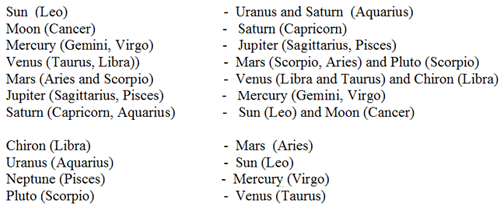 As usual in this series of articles, I have Chiron as the ruler of Libra. The incompatibility of two planets can also be because of their nature, for example Jupiter and Saturn, or Uranus with Venus or Chiron. The above table immediately confronts us with a nasty problem: Hone wrote: (p. 34) Principally classical rulers of signs are to be reckoned with as much as the new rulers. One should always try to give preference to the one that seems most corresponding to the nature of the house involved. If Pisces is on the ninth cusp, especially with Jupiter in the ninth house or aspecting this cusp, Neptune will almost certainly be put aside for Jupiter as the ruler of nine and vice versa. Further, in Morin's system, the sixth, eighth and twelfth houses are malefic, and so are in most cases their ruling planets, even Venus, especially if positioned in a non-fitting sign or badly aspected. This I think is not true for the corresponding signs Virgo, Scorpio and Pisces! (At least, this is one difference between signs and houses I am happy to admit.) Finally, we will accept planetary aspects to the hoyse cusps not only to the MC and the ascendant, but also to intermediate cusps, and in the radix as well as in progressions. The radical orbs should be taken a bit smaller than between planets but as we will see this gives unexpected results, especially when the aspect is from the planet that actually rules the cusp or that is its natural ruler (for example, sun to cusp five). The housing system that we will use is Placidus, since at least for the techniques discussed in this article gives excellent results. EXAMPLE OF THE PLANETS' VALUES IN THE SIGNSAs an example of how far we can get merely by looking at the value of the planets in the signs, we will now study the horoscope of the unfortunate Dutch politician. Pim Fortuyn. He was quite brutally murdered one week before the Dutch parliamentary elections in 2002 (where he could have easily win). For the Dutch, this is the equivalent of the murder of Kennedy for the Americans. 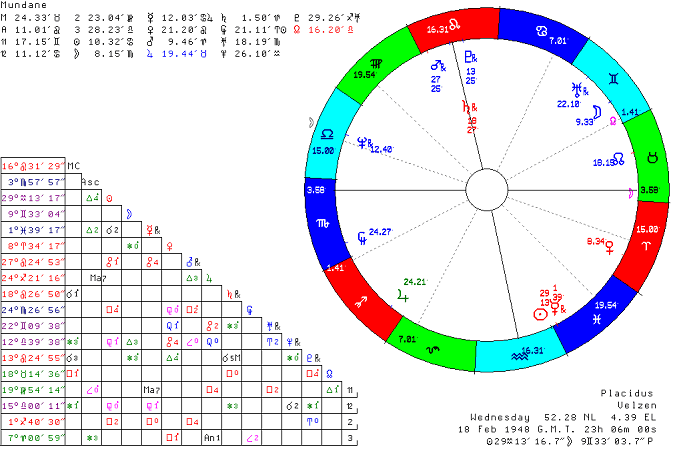 I gathered the above horoscope three days before his death, and I was immediately frightened: the first that stroke my eye was the conjunction of Saturn in Leo (its detriment) with the MC, made even worse because malefic Pluto, peregrine, also partakes in this conjunction. The ruler of these points (MC, Saturn and Pluto) is the sun, in its detriment in Aquarius and opposite to Mars, also positioned in Leo. This was enough to predict a heavy fall from a high position. If one accepts transgressional aspects there is even more to this: the sun, ruler of the MC etc. is positioned at the end of Aquarius (its detriment), and conjunct to Mercury, ruler of eight, also in its detriment in the beginning of Pisces. This is the only way, the only zodiacal position, where these two planets can be conjunct and both in their detriment. So we see a conjunction of the rulers of ten (career) and eight (death), both in their detriment. And just look, both are in a square to the cusp of the eighth house ruled by Mercury. In the eighth house we see the moon (public) and Uranus (suddenness) in Gemini; indications of a sudden public death. The murder took place on the street in the Hilversum "Mediapark" (center of journalism, tv, etcetera) which is typically Gemini too. Also note the position of Neptune, natural ruler of twelve (the traditional secret enemies) on the cusp of twelve, semi-square to Mars (violence) and also opposite to its ruler Venus in its destruction in Aries. Yes, astrology can be frightening. Once more we see that a planet is heavily afflicted when in opposition to its ruler: Mars to the sun, Neptune to Venus. The opposition in itself is no worse aspect than the square, but in such cases the ruler will by definition always be in its detriment too, and that makes things worse. CUSPRULERSI now introduce the idea of cusprulers, not to be confused with houserulers. A cuspruler of a house is a planet that actually is positioned on the house cusp or whose degree of exaltation is on this cusp. Aspects between cusprulers are very important. In my own horoscope: 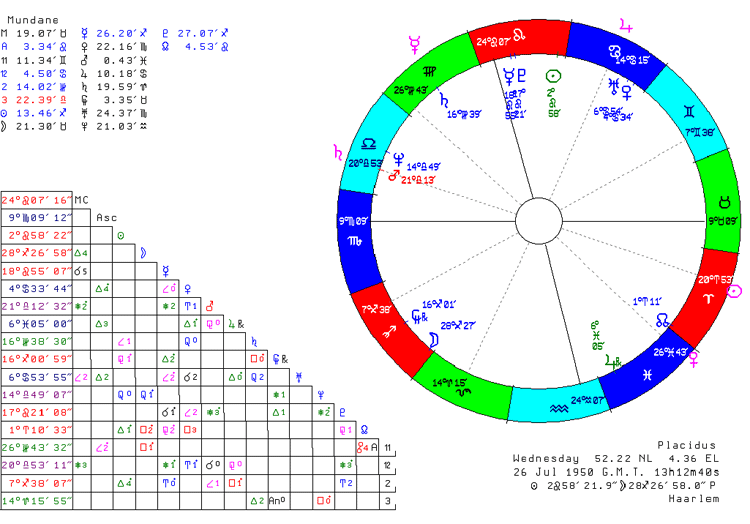 Venus is the exaltation ruler (cuspruler by exaltation) of five and Jupiter of nine, they are in a trine and therefore this is one indication why I got married to a girl from a foreign country. My Jupiter also is in sesquiquadrate to Mars in its detriment, cuspruler of twelve and regular ruler of six. This is an indication that I was probably infected abroad, on a foreign summercourse (Jupiter!) in Moscow in 1975, with the most important illness of my life, a rather malevolent and long lasting Pfeiffer. One might say that my trine of Venus, natural ruler of seven, to Jupiter, natural ruler of nine, is in itself already a clear indication for a marriage to a foreigner but this aspect of course lasted for days, and it needed to be stressed, personalised, by cusp-positions in order to become valuable. Slightly less important I suppose is the position of a house-ruler in the house it rules, not conjunct to its cusp (then it would be its cuspruler), for example, Uranus in Marie Antoinette's horoscope : 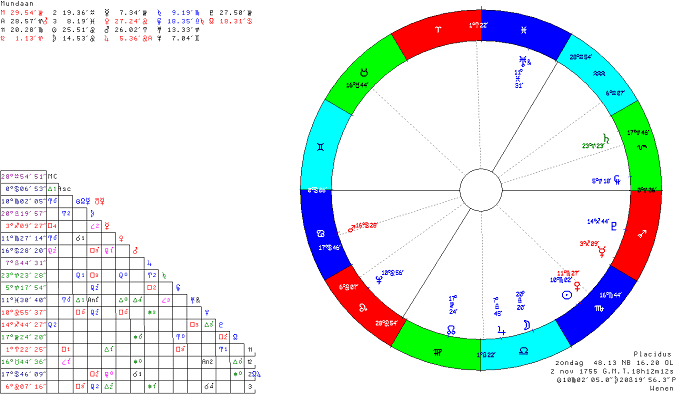 Here we see Uranus, ruler of ten, in the tenth house, although not in its own sign. It is in a semi-square to Saturn in its own sign in eight so the end of a prominent position, a fall, through revolution and a violent death was indicated. There is the age-old problem of what planet has the strongest influence on a house:
ANTISCIONAL POINTSThe last indications I want to mention are traditional: the antiscional points, already mentioned by Ptolemy. They used to be neglected in modern astrology since they are difficult to find by simple visual inspection, but thanks to the arrival of computers they are becoming increasingly popular now. Two points are said to be antiscional if they are on different sides from 0 Cancer but their distances to 0 Cancer are the same. For example 0 Gemini and 0 Leo, both points being 30 degrees from 0 Cancer. This is considered to act like a conjunction, both in the radix and in progressions. Antiscions between a planet and a cusp can be very effective too. In the horoscope of Richard Nixon we see a special but not uncommon case, that mostly goes unnoticed: 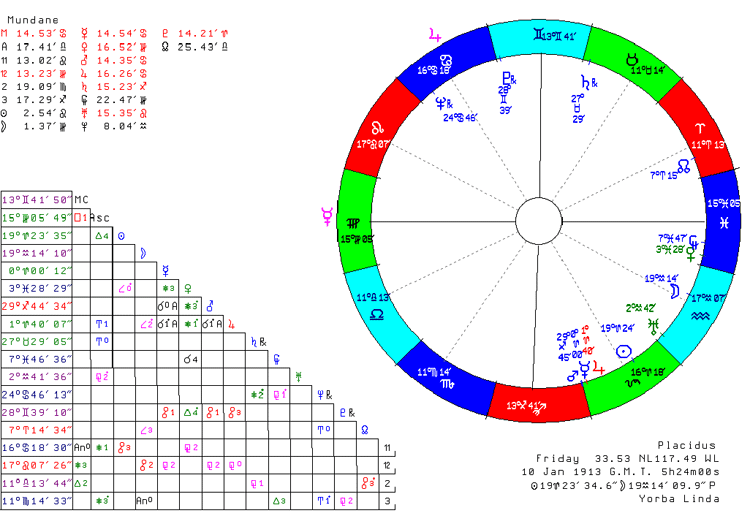 Planets at the end of Gemini are conjunct to planets at the beginning of Cancer both regularly and by antiscions, just like planets at the end of Sagittarius and the beginning of Capricorn. This explains why in this horoscope the stellium formed by Mercury, Mars and Jupiter proved to be so sensitive to the opposition of Pluto. (How much better his career would have ended if only Mars and Jupiter had occupied each other's positions, both would have been excellently placed!) THE MORINIC-SYNTHETIC METHODMorin convincingly mocks with the idea that a planet's position in a sign has the same meaning for anyone born during that period (Morin, p. 11 = 17,15). Holden (p. 165) states that Morin entirely rejected any fixed meaning of planets (f.e. the moon for the mother) and used only rulerships and placements in houses where a planet actually happens to be positioned, but that nevertheless he maintained something called analogies. And indeed, Morin, p. 14=21,19) states: "And so, careful attention should be paid to the planets' location by house, or their house-rulerships, and to whether they aspect favourably or unfavourably a planet having an analogy with the meanings of these houses, and what the celestial state and determination of this other planet may in turn be. From all this a very accurate prognostication can be made, for herein lie the secrets of astrology". For the case of clarity and since it is such an important statement, I cite here Lucy Little's translation aS well: "One must therefore examine with the greatest care whether the planets which occupy a house or who are rulers there are in favourable or unfavourable configuration with the planet whose significance by analogy [i.e. by nature, WvD] is the same as that of the house: then one must consider the zodiacal state of this latter planet and its specific determination of the chart". Most important lines but what do they actually mean? My interpretation is: We may even extend this rule: when a planet is positioned in a house and it is in aspect to another planet in the corresponding sign (f.e. a planet in four in aspect to a planet in Cancer), this aspect will be very important in the affairs ruled by this house. The same with a housecusp in aspect to the natural or actual ruler of the house. DEFINING OUR THESISGenerally speaking, in the method proposed in this article, we try to find a relation between a general zodiacal indication in the signs and a similar particular mundane indication in the houses. My proposal is to realize this by looking for a link between a house and its corresponding sign, by whatever means (usually an aspect between two planets or between a planet and a cusp). An example from my own horoscope: 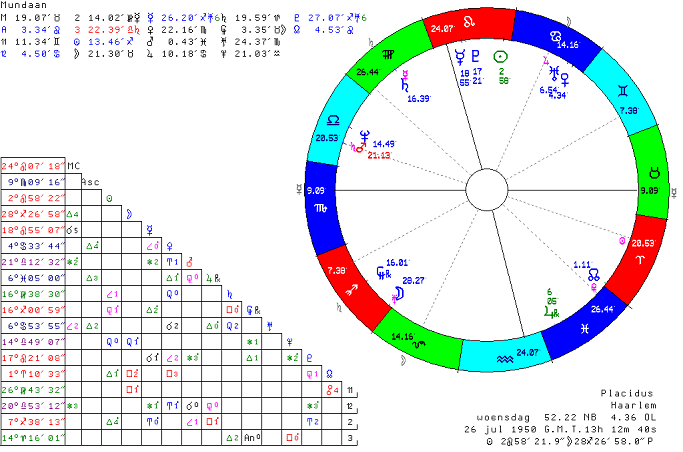 Here we see the lunar node in the fifth house, in a trine to the sun in Leo, the fifth sign, in nine. Since the Sun and Leo and the node and the fifth house all have influence on romantic relationships, this would be one more indication for foreign love-affairs (ninth house). The same indication is given by Neptune, actual ruler of the fifth house, in quintile to the sun in nine, natural ruler of the fifth sign. The essence of this article: 1 : with one planet: POSSIBLE OBJECTIONS REFUTEDHaving come so far, even the most benevolent reader might remark: "But Mr. Van Dam, this method is exactly what you accuse other astrologers of. You will always find a relationship between any two planets or cusps and you will always find material to read in a horoscope whatever you want to find. The more so since you not only use aspects but also degrees of exaltation, mundane positions, etc." But this would be completely wrong. First, I don't attach fixed meanings to aspects and for that reason also not to any house-sign relationship. So I cannot strive towards any desired concrete fixed meaning just by checking as many house-sign relationships as I need to finally reach the desired significance. If we don't just look which two planets form an aspect but also look what value they have (in what signs they are positioned) and which house-sign relationship they have, we get far more different possibilities for that one aspect. Yet, they are far less poly-interpretable because of their strict house-sign-relationships. Remember that in such a relationship the house involved will always be the same as the sign, which means that you probably know in what field of life the indication or event will happen. Here lies the power of the system. Second, one should always remember Robert de Luce's Golden Rule of Interpretation: one indication is a possibility, two are a probability and one needs three for reliability. In the example above, we found until now only two indications for foreign love affairs. This is solved by the third rule: Of all indications found, at least one should be individual, personal, in time and place. It seems that in practice, for one reason or another, this often is a conjunction to a mundane planet or cusp. In my horoscope, 0 Aries is positioned in the beginning of the fifth house and my mundane ascendant proves to be 3.32 Leo, almost exactly conjunct to the sun in 2.58 Leo in nine. So my mundane ascendant activates the double house-sign indication discussed above, and makes it personal. It also suggests the nature of these relationships, marriage, since the ascendant-descendant axis relates to marriage. Suppose the individual point on my sun in Leo in nine had not been the ascendant-descendant axis, but the cusp of the second house. Then an acceptable interpretation would have been: financial gain (cusp 2) by gambling or speculation (five) abroad (nine). So the nature of all points involved should always be reckoned with too. This example shows once more why you cannot superimpose any desired significance to any house-sign relation you find, the meaning of the individualizing cusp or mundane planet should be fully reckoned with. So we see that indeed, a planetary constellation that is stressed by a cusp is more likely to show its effect. Only as said, I have got the impression it will often be a mundane cusp or planet that has the same properties and speed as a regular cusp, albeit backwards in the zodiac in stead of forward. Important note: There are even more indications for foreign love-affairs in my horoscope: the sun in nine is in sesquiquadrate to Chiron (ruler of Libra, as I suggest) in the ninth sign, and Chiron's mundane longitude is at 3 Taurus, the moon's exaltation. The moon rules my ninth house, so Chiron-like affairs (love, relationships) are indicated by the sun and the moon, masculine and feminine principles par excellence. Both are related to the ninth house, meeting each other on Chiron and the more so since right on Chiron we also see antiscional cusp three. This is to be understood as another indication of a foreign wife, since the significance of this antiscional axis three in Sagittarius, the ninth sign, is almost automatically drawn towards its opposite, cusp nine: foreign affairs. So much for the positive side of my horoscope. But now for something completely different: the undeniable negative and disharmonic influence, until about my eighteenth year, of my grandparents by mother's side on our domestic life. Jan Gieles taught me that grandparents are reflected by the twelfth house. Here we find malevolent Mars in Libra (most unfitting quarrelsome position) on the cusp, in sesquiquadrate to Jupiter in the fourth house (domestic life). Mars and cusp twelve also are in Saturn's degree of exaltation, indicating both stress and elder people. This is a clear indication (first cluster), but could it be even enforced by using the house-sign principle? Most certainly, if we only take into account that not only Mars is in the twelfth house but Jupiter is in Pisces, and in the twelfth sign, too. But there are more indications in my horoscope: quarrelsome Uranus, ruler of the fourth (parental, maternal) house, is positioned in Cancer, the fourth sign, in conjunction with Venus (together meaning domestic disharmony), and also in a nice transgressional opposition to its ruler the Moon, that happens to be the natural ruler of four (second cluster). And the cause for this disharmony is clearly given by Mars throwing a tredecile to Venus and thus linking both clusters. This second cluster is the promised example of a combined house-sign relation: 1A : ruler (Uranus) of a house (four) positioned in sign four, Cancer The third indication might be a surprise: as we saw, the first cluster, Mars and Jupiter, is centered on regular cusp twelve. This makes the indication individual enough, but 0 Pisces is in the beginning of the fourth house, giving a mundane twelfth cusp of 4.50 Cancer, exactly conjunct to the second cluster, Venus conjunct Uranus. We now not only have a double individual indication but both indications are through cusp twelve, grandparents: Mars, cusp-ruler of twelve, is conjunct to regular zodiacal cusp twelve and Venus, classical ruler of twelve, to mundane cusp twelve. In addition to the tredecile between these two planets (a technical relationship), this connects the two clusters by a semantic relationship (twice cusp twelve) as well. In the house-sign system of interpretation we also reckon with cusp-rulers. A fine example is provided once more by Pim Fortuyn's horoscope: the cusp of the eight house is in the node's exaltation degree and the node is in semi-square to violent Pluto, natural ruler of eight. Not a desirable configuration, and a nice illustration of the rule that the ruler of a house (here the exaltation ruler) in aspect to its natural ruler gives most valuable information on this house. Now we also understand the importance of what I wrote some pages ago on the position of Neptune in this horoscope, natural ruler of twelve (the traditional secret enemies) on the cusp of twelve, semi-square to Mars (violence) and also opposite to its actual ruler Venus that is in its destruction in Aries. Since Neptune is the natural ruler of twelve and Venus the actual one, this proves to be a typical house-sign relationship. EXTENSION OF LINKSSome indications are stronger (more synthetic, repetitive) than others. I gave as examples in my horoscope the trine from the node in five to the sun in Leo. Actually, five and Leo in itself would be a sufficient house-sign relation and any other intermediate planet in stead of the sun (Mercury, Neptune) would do. But the indication of course is stronger since the sun, natural ruler of five/Leo is involved. The presence of another planet would make necessary another interpretation. Thus we see that a sign-house relation based on an aspect between two planes in corresponding house and sign can be intensified by one of the planets being the natural ruler of the house and sign (type #1, for example, my node in five trine to my sun in Leo). The reversed also exists: when we have a sign-house relation created by an aspect between the actual and the natural ruler of a house, one of the two planets (or both) may be positioned in the sign or house involved. In my quintile from Neptune, actual ruler of five, to the sun, natural ruler of Leo, we need only the two planets for a full sign-house relation. But the sign Leo is once more involved by the sun having its position in it, making the interpretation easier and more reliable ( type #2). Remember that in the Mars-Jupiter cluster in my own horoscope Jupiter is both classical ruler of and positioned in Pisces. In the same way, the opposition of Neptune and Venus, natural and actual rulers of twelve in Pim Fortuyn's horoscope, mentioned above, was positioned on his axis six - twelve, so in stead of houses cusps also may give this helpful double information if they enforce, link up with, an already existing house-sign relation. Type #3 that may intensify a house-sign relation is when the two planets involved not only are in an aspect to each other, but are also in a mundane conjunction. Here too my node - sun relation is a good example, for the node's mundane longitude is 4.53 Leo, conjunct to the radical sun in nine. This means that the house-sign relation given by the trine between the sun and the node is reinforced both by the sun being positioned in Leo and by the node being in mundane conjunction to the sun. Now we fully see why this house-sign relation worked out so clearly in my life. We should always check for such additional indications, they are most important. THE TWO KINDS OF INDICATIONSIt is I think impossible to state all possible kinds of house-sign relations. But the following should be well noted: There are a) purely technical relations (aspects, antiscions and the mundane positions), and b) semantic ones: the interpretation one can give for these aspects in view of their house-sign relations and their possible reinforcements. We may conclude that the traditional textbooks try to give a fixed significance for the first ones as if they are the endpoints for the analysis, while in fact the aspects only give rise to house-sign relations, that should be dynamically interpreted, in the light of the nature and the cosmical position of the two planets involved. One might compare this to a skeleton: true, it is essential for a body but one cannot say much interesting from looking at its bones (the aspects) alone. Only when this skeleton (the zodiac and the aspects) is clothed with muscles and skin (house-sign relations) we can recognize the native. Because of lack of space I will not dwell here upon other applications of the house-sign system (by using midpoints, Volguines "Encadrements", etc.), but there is one very important application that should be discussed here: its use in progressions. I am a convinced user of primary directions as I developed and published them myself some thirty five years ago and have found since then no reason for substantial adjustments, except for a slight adjustment of the key of time . The system sometimes is known abroad as "the Dutch system", since some Dutch astrologers are convinced of its value but wouldn't like you to know that it was developed by yours truly, Wim Van Dam. In most cases the majority of indications found by these primary directions are simply interpreted by studying which houses are ruled by the planets involved. But in some cases, in addition to these applicable aspects, other ones are found unexplicable. White noise? This would be acceptable only if we knew on beforehand which indications are applicable and which ones are not. But we don't. It seems the house-sign principle may be helpful here too. Let me take as an example how the birth of our daughter Lily, January 10, 1995, was reflected in my horoscope. I discussed this event in the article on degrees of exaltation and showed that at least one otherwise unexplicable indication becomes clear by using these degrees. There were even more indications that are explained only by using house-sign relations (primary positions for the date are drawn in blue, secondaries in blue). 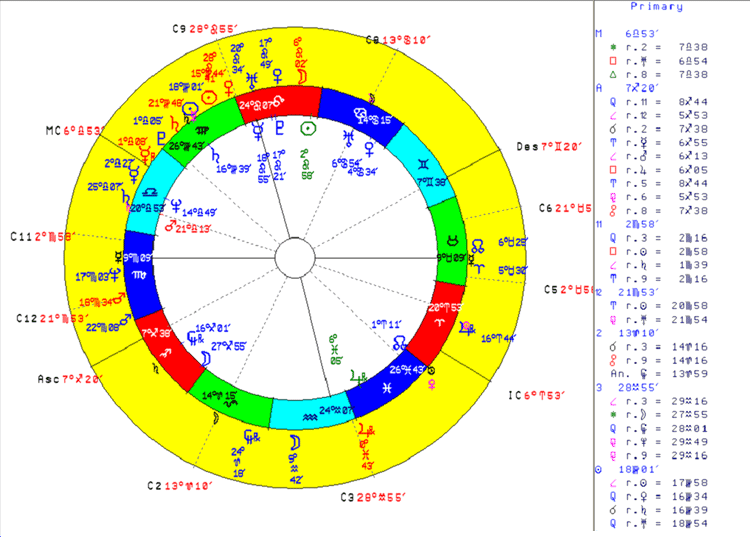 As I stated in the article, the most applicable indication was given by primary cusp 5 in 3 Taurus, square to the sun in Leo. Cusp five and Leo and the sun are clear indications for children but now we understand it was in fact a house-sign relation realized by cusps. More troublesome for interpretation are at first sight: Primary Jupiter trine to Pluto: A mystery, until you realise that primary Jupiter is the traditional ruler of five through Pisces and its primary position is in the radical fifth house, whilst radical Pluto is in Leo, the fifth sign. Easy like taking candy from a baby. Primary Venus conjunct to Pluto: realise that Venus is radical exaltation-ruler of five and radical Pluto is in Leo. Primary Jupiter tredecile (108 degrees) to the moon: As I stated above, my primary cusp 5 was in 3 Taurus. This happens to be the exaltation-degree of the moon, so the moon was cuspruler of five for that year, and primary Jupiter was in the fifth house. This means that both radical positions on degrees of exaltation and primary ones are important in the delineation of progressions. In case you don't like primaries, the secondary ones may be used as illustrations of the house-sign-principle too: the secondary sun (children) was in a sextile to Venus, exaltation ruler of the radical fifth house, and secondary Venus was in a trine to the radical moon (the moon being exaltation ruler of fifth that year). Very, very interesting: one of these indications was, as said, primary Venus conjunct to radical Pluto. At the time that secondary Venus had been conjunct to the same radical Pluto in 1986, I got engaged to my later wife. This too is a typical fifth house matter, and it is a good illustration that even if you figure out the right house, you are not sure of the right interpretation. At least if you don't take into account the other indications for that year. In solar revolutions too we can use the house-sign method. Let us take as an example Pim Fortuyn's solar revolution for the fatal year 2002, calculated for Hilversum, the Netherlands. 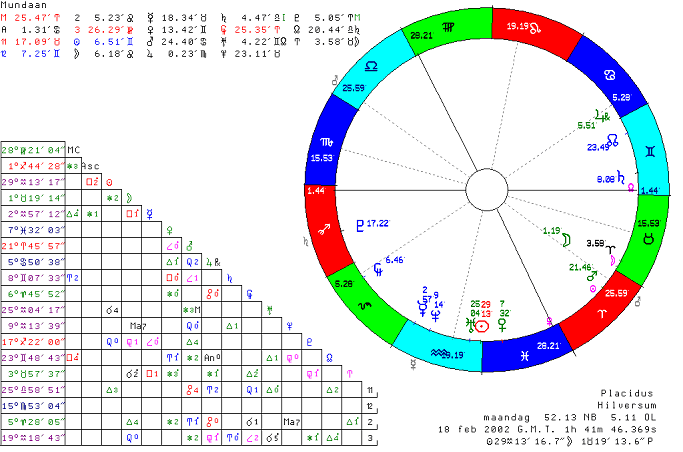 In addition to some traditional methods, easily interpretable indications like solar ascendant conjunct to radical cusp eight, we also see the moon, ruler of solar cusp eight, in sesquiquadrate to Pluto, natural ruler of eight. This is of course a repetition of radical node, cuspruler of eight through exaltation, semi-square to Pluto. Another repetition is the position of antiscional node conjunct cusp eight, remember the node's degree of exaltation being on cusp eight in the radix. The moon in its own degree of exaltation probably stresses the house it rules (eight), but how should we interpret Jupiter in the sign of its exaltation on cusp eight? At first sight most unapplicable for the victim of a murder but I suppose this is an indication that through this murder, Pim acquired eternal fame in the Netherlands at least (a few years later he was, rather overdone, elected the Greatest Dutchman Ever). Conclusion: In an ideal situation, there would be a complete system a la Hone of rather abstract key-words for every (harmonious and unharmonious) combination of two planets that should be applicable for all (twelve) possible combinations of sign and house. These would still be rather abstract, but would be clarified by the highly individual regular cusps or mundane points it coincides with. I hope I'll live to see this happend. Example: for Mars in a bad aspect to Saturn I would suggest "violence", but the degree of violence would depend on these planets' positions in the signs and on their rulers' positions, and the area of life on their house-sign relationship (if any). In the above examples I have used the house-sign principle within one horoscope (or between a horoscope and its own progressions). I have not yet developed a system how to apply the principle on relations between two horoscopes, for example between Pim Fortuyn's radix and his solar revolution for 2002. You might need to ask your programmer to adjust the program you use in order to reckon with all these techniques and relationships in radical analysis as well as in progressions, for like me you will never be able to find all these indications yourself. For my own program I did so, it took me more than several months to realize this and still I find little rules to add, especially in progressions Remember: you may have the searching for these house-sign relations programmed, just like checking for the aspects, but you cannot have an automatic interpretation. Finally, what is the difference between signs and houses? I don't know, and in fact it does not matter. As we have seen, in interpretation we often need the cooperation of the sign and the house, in other words the one cannot do without the other and we should not try to separate them until we know more about the difference between them. ADDENDUM : TWO INSTRUCTIVE HOROSCOPESThis is the horoscope of a woman who from birth on has got a serious physical handicap : she misses the bones between the right elbow and the hand and the right hand is cripple, leaving her only her left arm to write and work with. This of course is a typical Gemini/third house/Mercury matter, the question only being which of these three indications will hold good here. The surprising answer (though maybe not so surprising for those who have read and digested this article) is: all three of them, and intertwined. 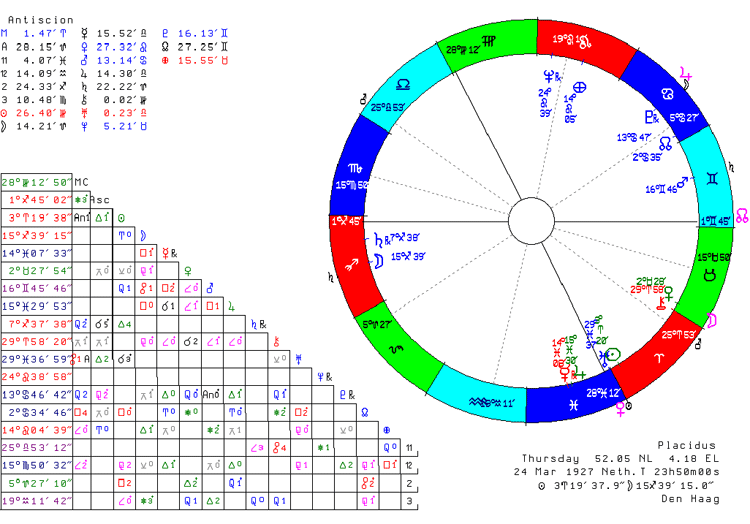 In the signs we see an opposition between the moon in the first house (physical in general) and Mars in Gemini. The two planets are both in a critical degree ruled by Saturn (cripple), which is a link to Saturn itself, also positioned in the first house. We might also say that Saturn stresses this opposition by its being in the same house and the opposition being in Saturn's critical degrees. So much for the signs. The planet Mercury has the most unlucky position: it is in Pisces, the sign of its detriment and fall (and in the very degree of its fall, but I doubt whether degrees of fall have any significance at all), conjunct to its natural opponent Jupiter. In order to make the list of indications complete, this unlucky conjunction is positioned in the third house. Both planets are linked through squares to the opposition Moon - Mars, the four together forming a classical T-square. Besides of this, Mars is in Gemini and Mercury and Jupiter are in the third house so their square is a good example of a house-sign relation, enforced by Mercury being involved. The opposition between the moon and Mars is from Gemini (hands) to Sagittarius (legs), which does not decide between the two. But the house involved is three, so the final effect by majority of votes relates to the hands (oh yes, how easy is backward astrology!). Here is an old rule in astrology (Sepharial, p.8) that in a man's horoscope the odd houses refer to the left side of the body and the even houses to the right side, and the reversed in a woman's horoscope. Here all four planets involved are positioned in an odd house, meaning the right side of the body. Finally, the ruler of the third house, Uranus, is in a transgressional conjunction with its natural enemy, the sun. Their influences are strengthened, personalized by their being placed in an antiscion to the MC. There is however at least one good side: the cusp of the third house is rather well aspected, the only technically bad aspect is from the sun. The Sun however is standing in the sign of its exaltation so its effect is finally good, and the sun and Uranus are in a trine to the ascendant. Also Mercury's conjunction to Jupiter finally, later in life, worked out positively, since Jupiter is a benefic in its own classical sign. I suppose these indications refer to her relative success in life through her intelligence: after of course a lot of bullying during her school years. Regardless of these truggles, she had a better career and good life than anyone had expected at her birth. At the age of 84, she is still doing reasonably well. The astrological problem however is that we have here is the badly occupied third house with a well aspected cusp that seem to result in a cripple arm and a good intelligence. Both typical third house affairs, and I really can't tell why it did not result the other way round (or does intelligence always depend on the cusp of the third house?). This is the same problem we met above with the indications for our daughter's birth and for my engagement, both typical fifth house affairs. We haven't yet got rid of our old friend poly-interpretability. The second horoscope I want to discuss is a luckier one. It is the horoscope of my friend Jan (the one who would not believe anything was to happen to me in Russia, see https://www.astrosoftware.com/WimvanDam.htm ).
Throughout his school career Jan was a very intelligent boy, who at school excelled in and later quite successfully studied mathematics. Once our teacher of mathematics told his parents how she feared Jan, 14 years old, raising his finger for then she invariably thought 'Good Heavens, where did I go wrong this time ?' What indications, presumably concerning Mercury and its houses and signs do we find for this intelligence? Traditional ones are: the exact trine between the Moon and Mercury, part of a transgressional grand trine with Mars in three, Mercury being in Capricorn, the sign of Saturn (mathematics). The moon is in a tredecile to cusp three, thus linking the grand trine to this cusp. With the tools used in this article we see Mercury's degree of exaltation on cusp three. Could we think of a better, a more natural place? This is a perfect example of the principle that the general zodiacal (here 15 Virgo) should be in agreement with the particular mundane (here cusp three.) In addition to this, on the cusp of the third house we not only find Saturn itself, but the cusps three and nine are in Saturn's critical degrees too. It is of course this repeated influence of Saturn in combination with Mercury that directed his intelligence towards mathematics. The most astonishing features however are the conjunctions of mundane cusp three with radical Mercury and, the other way round, of mundane Mercury with radical cusp three. Such a double reciprocal indication is very rare and it stresses once more the value of cusp three and Mercury in this horoscope. Note that mundane Mercury is not only conjunct to regular cusp three but also to Saturn. This cusp three provides us with an impressive mixture of Mercury and Saturn. Very nice in the light of this article is the tredecile, a house-sign relation, between Neptune (ruler of nine, study) and the natural ruler of nine, Jupiter But the most striking interaction we found is the one between cusp three and Mercury: Mercury is both natural and actual ruler of three and ruler by exaltation and has got a double mundane conjunction with cusp three. Mercury is also stressed by its critical degrees being on the axis ascendant-descendant. Once more, for an important fact in life we see that there is an interplay between the planet involved (Mercury), the occupation of the house it rules (three) and the cusp of this house. Gemini is not involved but Mercury's other sign, Virgo, certainly is (I do think Virgo is more characteristic for mathematics than Gemini, that I link more to languages). And just like with the preceding horoscope, we find cusp three the main indicator for intelligence. As we say in science, more research is needed here. There is a bad side of this Mercury too: it is placed in Mars' degree of exaltation, Mars being weak in Libra, and the moon that makes a trine to it is ruler of the twelfth house. Since Mercury is placed in the sixth house and the sun, ruler of the ascendant, is on the cusp of six, I suppose this relates to the hereditary disease in his family that caused the death of two elder brothers soon after birth, probably indicated by the square between weak Mars in three (brethren) and Uranus, ruler of eight. Jan himself was only slightly touched by this disease (thanks to the tredecile between the sun in the sixth house and its ruler Saturn in the sixth sign, a positive house-sign relationship, reinforced by the sun's position in Capricorn ?). Since the IC is in the exaltation degree of Saturn, ruler of six, it is highly seductive to see a relationship between the sixth house, diseases, ruled by Saturn, and the IC, heredity. It is interesting how the very same trine between Mercury in the degree of Mars' exaltation in the sixth house and Mars in the third house at one side probably favourably influenced the native's intelligence and at the other side indicates a serious disease in his family. At present I don't know how to propose a rule that comprises and discerns between both meanings, good and bad. The reason why I publish these two horoscopes is that they show once more De Luce's Golden Rule that for hard facts in life more than one indication is necessary. So often I hear that I use too many tools to show a fact of life from a horoscope: "but Wim, don't you see this or that indication suffices, you really don't need all these other ones." My answer is that I DO need more than one indication, some of them general some of them particular, whether they are provided by purely traditional indications or by the more advanced tools I had the honor to show to you in this and in the preceding articles. Final remark: References:
|

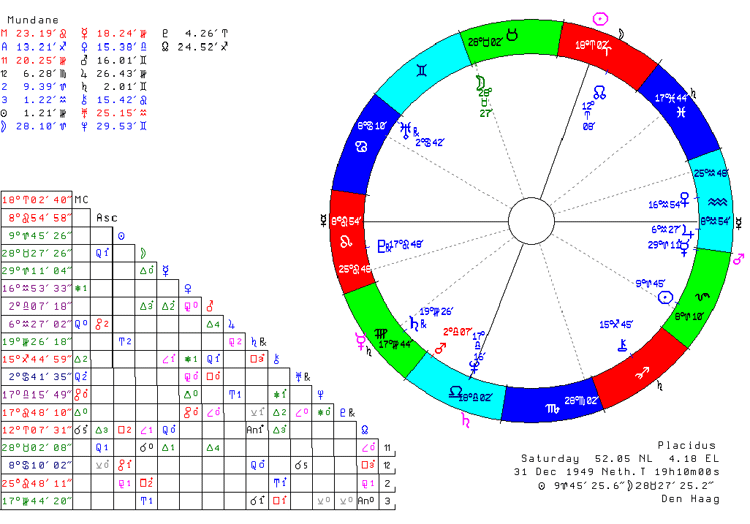
 AUTHOR:
AUTHOR: 